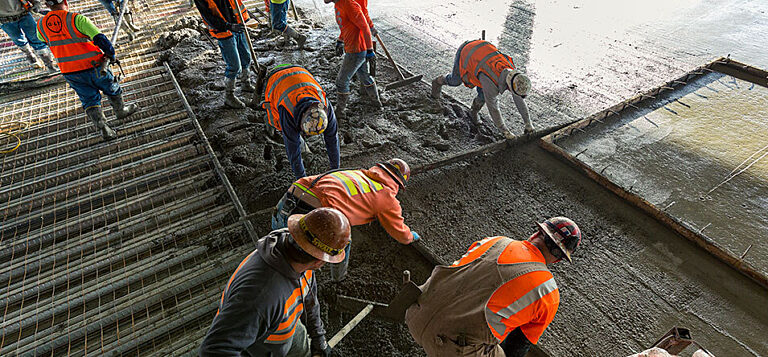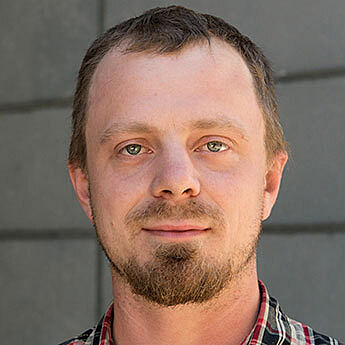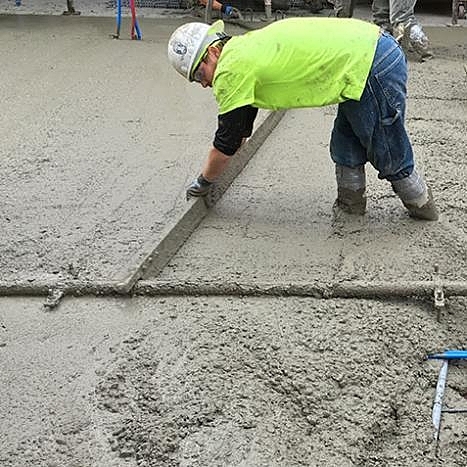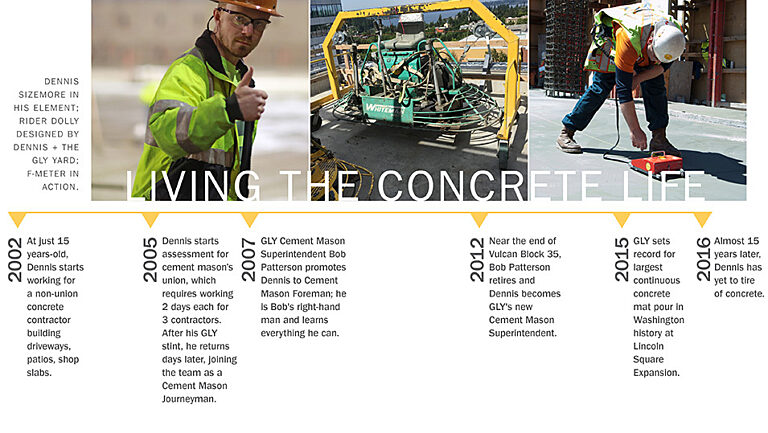Collaborative Delivery

Insights 08.06.2025
The Weekly Podcast with Rachel Horgan

Tess Wakasugi-Don
Principal


con∙crete [kán krét]: a heavy, rough building material made from a mixture of broken stone or gravel, cement, and water, that can be spread or poured into molds and that forms a stonelike mass on hardening.
Think of any iconic structure defining our modern world and chances are, concrete played a big role in its creation: Hoover Dam, the Panama Canal, the Petronas Towers, the Burj Khalifa and Chesapeake Bay Bridge are all examples of this versatile material in its most impressive forms. And concrete has a long history. Another building that belongs on that list but wouldn’t come first to mind is the Pantheon in Rome. This 2000-year-old building is still the world’s largest unreinforced concrete dome and one of the best preserved of Rome’s ancient buildings, still in use today.
You might think that a material that has been around for so long and with such a successful track record leaves little room for improvement—but that’s not what GLY Cement Mason Superintendent, Dennis Sizemore, thought …

Even with concrete, there's always room for improvement.
Despite the material’s impressive history, the methods for pouring and leveling concrete remain remarkably variable—and the results achieved are, predictably, equally variable. Dennis and his crew weren’t satisfied with the way things were working and saw room for improvement.
There are two important measurements that determine the quality of a concrete floor: FL [levelness] and FF [flatness]. FF-50 is considered ‘very flat’ and achievable for a straightforward job such as laying a slab on grade in a high bay warehouse. Highrises are a lot trickier due to the fact that the elevated decks placed are less stable than slab-on-grade. Thus, the industry standard for flatness is adjusted accordingly: FF-30. When it comes to levelness, FL-20 is the standard—whether slab-on-grade or elevated.
Aside from the obvious benefits of having a flat, level floor so that your drawers don’t fly open and you don’t trip as you walk along a corridor – inaccuracies in flatness and levelness can be costly.
For example, tile setters measure by eighths [1/8″] of an inch. In a long base hotel corridor or somewhere with a lot of casework, the levelness is critical to the function of the design. Imperfections may be covered with carpet or tile – but it has to be flat. When it isn’t the owner ends up with nuisance back charges from the flooring or casework contractors and repairs run up to double the cost of doing it right the first time.
So how do you eliminate the risk of error? Over the course of his 15-year career, Dennis had plenty of opportunities to notice where in the process things started to go wrong.
Nowadays, his approach centers on bringing everyone together from the get-go; together they agree on what needs to be done, how they’ll do it, and who will be responsible for each important task.
He begins by working with the carpenter and methodically planning the layout. It’s the job of Dan Frye, GLY’s Layout Manager, to make sure the form slab is at the correct elevation and that the sleeves to accommodate the MEP infrastructure are at exactly the right height—not too high, not too low. It’s the Goldilocks equation of ‘just right’ that sets the whole process up for success.
The traditional concrete pouring approach on any elevated deck is to set [shoot] pins throughout the slab, place a screed bar between them, and pour concrete from one end to the other, up to the height of the bar. The problem with this method is that structural beams settle in the middle and tend to sag, and the grade in the middle of the site is lower than the edges. To solve this dilemma, Dennis turned things upside down—quite literally. He devised his own piece of equipment: a screed bar constructed from 2″ pipe with adjustable pins already attached, custom-made by the GLY Tool and Equipment Yard team. The contraption resembles giant staples attached perpendicularly at intervals to a long connecting bar. He sets the points of the staples into the wet concrete along the structural beams in the center of the site and pours until the level reaches the connecting bar, ensuring the elevation of the concrete in the center is identical to the level around the perimeter. The bar is removed before the concrete sets and used on the next section. Simple, effective, and perfect.

Traditional method of using pins for achieving grade [pins are set/attached to the ground and a screed bar rests on top].

Custom GLY grade measurement tool used for an even flatter pour [no need to shoot pins].
Dennis and his crew also take time to educate the contractor responsible for the formwork to make sure that they understand exactly what’s expected. It’s all about preparing the groundwork meticulously.
Once the concrete is placed, the finishing crew takes over. Just as before, Dennis begins with careful planning, walking the floor with the foremen to determine where best to start and finish.
One of the first things Dennis did after becoming Superintendent was to expand GLY’s fleet of finishing equipment. These machines known as power trowels—and the skill of their riders—are the key determinants of final quality.
It’s not easy getting these 1600 lb machines up a 32-story steel structure tower, the situation on GLY’s Lincoln Square Expansion [LSE] South Tower project. On concrete structures, using a crane does the trick because concrete finishing is completed before the next level is built above. A crane simply lifts and sets the rider on the uppermost level through the open ceiling. For steel, that open ceiling doesn’t exist; the steel structure portion is completed in advance of each concrete pour.
To solve this problem Dennis and his team designed a dolly to get the riders up high-rises. They used a similar technique for Vulcan’s Block 52E tower and perfected the process for LSE. Many contractors faced with the same situation abandon the riders and opt for the more maneuverable walk-behinds. You can get a floor to pass the flatness requirement with a walk-behind—but not to Dennis’s standard.
Dennis has a seasoned team of rider operators who are all long-time GLY employees. They know what he expects and what’s required. There are typically three trailing machines that go across the floor. The first is like a big pizza pan. It cuts any little humps and fills small holes and lines. After this first pass come two more machines with trowel blades. Each cross the floor twice making alternate passes. As soon as the concrete hardens, it’s time to check the results.
The final piece of equipment that crosses the floor is the F-Meter. The F-Meter inspection is usually conducted by a third party but, for our own quality standards, GLY has 10 F-Meter certified staff who monitor each job and distribute a report card. Trundling along behind its leash, the F-Meter records the flatness and levelness of the final result. LSE South Tower achieved FF-55 —far exceeding ACI requirements for a high-rise.
Although this standard of quality may never be seen by anyone other than Dennis, his crew and the flooring installers, it is emblematic of the level of dedication, workmanship and pride that goes into every aspect of GLY’s project delivery. When we work alongside people like Dennis, it inspires every one of us to produce the best work we can.
Concrete Pouring Glossary
F-Meter Floor profiling meter. Measures flatness and levelness.
Screed Bars Flat steel rod used to set elevation for the crew screeding the slab to the proper grade and smoothness.
Power Trowel Equipment used to apply a smooth finish to concrete slabs.
Riders Ride-on power trowel operator. Highly skilled.
Walk-Behinds Power trowel operator who walks behind the machine as opposed to sitting.
FF Measure for Floor Flatness. FF-30 is standard as of October 2014. The higher the number, the flatter the slab.
FL Measure for Floor Levelness. For slab-on-grade,
FL-20 is standard. FL doesn't apply to steel structures because the camber [arch] in steel beams does not allow an FL measurement. Cambered beams curve slightly upward, offering superior support by reducing sagging from the weight of a concrete floor.
Shooting the Pins Using a laser to shoot final grade on the screed pins.


Cement Mason Superintendent
Dennis is the go-to guy on anything and everything concrete. At age 15, he poured and finished driveways, patios, and shop slabs. When he started at GLY at 18, he was the youngest journeyman in his union. Today, he's a concrete master who oversees projects up to one million square feet. His favorite aspect of the job is the constant change of scenery since he's not on one single project for an extensive amount of time. While concrete is a big part of Dennis’s life, he makes plenty of room for his kids, fishing, hiking, and visiting Kauai, his happy place.